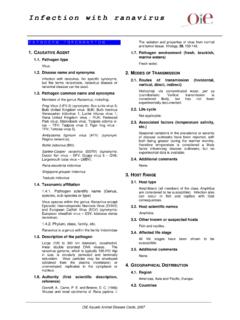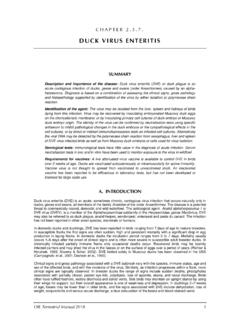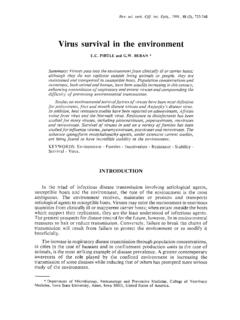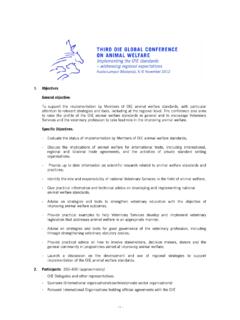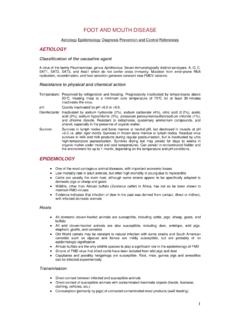Transcription of Description of the disease - Home: OIE
1 Description of the disease : Lumpy skin disease (LSD, knopvelsiekte) is a poxvirus disease of cattle characterised by fever, nodules on the skin, mucous membranes and internal organs, emaciation, enlarged lymph nodes, oedema of the skin, and sometimes death. The disease is of economic importance as it can cause a temporary reduction in milk production, temporary or permanent sterility in bulls, damage to hides and death due to secondary bacterial infections. Various strains of capripoxvirus are responsible for the disease . These are antigenically indistinguishable from strains causing sheep pox and goat pox yet distinct at the genetic level. LSD. has a partially different geographical distribution from sheep and goat pox, suggesting that cattle strains of capripoxvirus do not infect and transmit between sheep and goats. Transmission of LSD. virus (LSDV) is thought to be predominantly by arthropods, natural contact transmission in the absence of vectors being inefficient. Lumpy skin disease is endemic in most African and Middle Eastern countries.
2 In 2015 and 2016 the disease spread to south-east Europe, the Balkans and the Caucasus. Pathology: the nodules are firm, and may extend to the underlying subcutis and muscle. Acute histological key lesions consist of epidermal vacuolar changes with intracytoplasmic inclusion bodies and dermal vasculitis. Chronic key histological lesions consist of fibrosis and necrotic sequestrum Identification of the agent: Laboratory confirmation of LSD is most rapid using a real-time or conventional polymerase chain reaction (PCR) method specific for capripoxviruses in combination with a clinical history of a generalised nodular skin disease and enlarged superficial lymph nodes in cattle. Ultrastructurally, capripoxvirus virions are distinct from parapoxvirus virions, which causes bovine papular stomatitis and pseudocowpox, but cannot be distinguished morphologically from orthopoxvirus virions, including cowpox and vaccinia viruses, both of which can cause disease in cattle. Neither of these viruses, however, causes generalised infection and both are uncommon in cattle.
3 LSDV will grow in tissue culture of bovine, ovine or caprine origin, although maximum yield is obtained using lamb testis or bovine dermis cells. In cell culture, LSDV causes a characteristic cytopathic effect and intracytoplasmic inclusion bodies that is distinct from infection with Bovine herpesvirus 2, which causes pseudo-lumpy skin disease and produces syncytia and intranuclear inclusion bodies in cell culture. Capripoxvirus antigens can be demonstrated in tissue culture using immunoperoxidase or immunofluorescent staining and the virus can be neutralised using specific antisera. A variety of conventional and real-time PCR tests as well as isothermal amplification tests using capripoxvirus-specific primers have been published for use on a variety of samples. Serological tests: The virus neutralisation test (VNT) is the only validated serological test available. The agar gel immunodiffusion test and indirect immunofluorescent antibody test are less specific than the VNT due to cross-reactions with antibody to other poxviruses.
4 Western blotting using the reaction between the P32 antigen of LSDV with test sera is both sensitive and specific, but is difficult and expensive to carry out. Some antibody-detecting enzyme-linked immunosorbent assays (ELISAs) have been described but none is sufficiently validated to be recommended for use. Requirements for vaccines: All strains of capripoxvirus examined so far, whether derived from cattle, sheep or goats, are antigenically similar. Attenuated cattle strains, and strains derived from sheep and goats have been used as live vaccines against LSDV. Lumpy skin disease (LSD) was first seen in Zambia in 1929, spreading into Botswana by 1943 (Haig, 1957), and then into South Africa, where it affected over eight million cattle causing major economic loss. In 1957 it entered Kenya, associated with an outbreak of sheep pox (Weiss, 1968). In 1970 LSD spread north into the Sudan, by 1974 it had spread west as far as Nigeria, and in 1977 was reported from Mauritania, Mali, Ghana and Liberia.
5 Another epizootic of LSD between 1981 and 1986 affected Tanzania, Kenya, Zimbabwe, Somalia and the Cameroon, with reported mortality rates in affected cattle of 20%. The occurrence of LSD north of the Sahara desert and outside the African continent was confirmed for the first time in Egypt and Israel between 1988 and 1989, and was reported again in 2006 (Brenner et al., 2006). In the past decade, LSD occurrences have been reported in the Middle Eastern, European and west Asian regions (OIE, 2016). Lumpy skin disease outbreaks tend to be sporadic, depending upon animal movements, immune status, and wind and rainfall patterns affecting vector populations. The principal method of transmission is thought to be mechanical by arthropod vector (Tuppurainen et al., 2015). The severity of the clinical signs of LSD depends on the strain of capripoxvirus and the age, immunological status and breed of host. Bos taurus is more susceptible to clinical disease than Bos indicus; the Asian buffalo has also been reported to be susceptible.
6 Within Bos taurus, the fine-skinned Channel Island breeds develop more severe disease , with lactating cows appearing to be the most at risk. However, even among groups of cattle of the same breed kept together under the same conditions, there is a large variation in the clinical signs presented, ranging from subclinical infection to death (Carn & Kitching, 1995). There may be failure of the virus to infect the whole group, probably depending on the virulence of the virus isolate, immunological status of the host, host genotype, and vector prevalence. The incubation period under field conditions has not been reported, but following inoculation is 6 9 days until the onset of fever. In the acutely infected animal, there is an initial pyrexia, which may exceed 41 C and persist for 1 week. All the superficial lymph nodes become enlarged. In lactating cattle there is a marked reduction in milk yield. Lesions develop over the body, particularly on the head, neck, udder, scrotum, vulva and perineum between 7 and 19 days after virus inoculation (Coetzer, 2004).
7 The characteristic integumentary lesions are multiple, well circumscribed to coalescing, 5 cm in diameter, firm, flat-topped papules and nodules. The nodules involve the dermis and epidermis, and may extend to the underlying subcutis and occasionally to the adjacent striated muscle. These nodules have a creamy grey to white colour on cut section, which may initially exude serum, but over the ensuing 2 weeks a cone-shaped central core or sequestrum of necrotic material/necrotic plug ( sit-fast ). may appear within the nodule. The acute histological lesions consist of epidermal vacuolar changes with intracytoplasmic inclusion bodies and dermal vasculitis. The inclusion bodies are numerous, intracytoplasmic, eosinophilic, homogenous to occasionally granular and they may occur in endothelial cells, fibroblasts, macrophages, pericytes, and keratinocytes. The dermal lesions include vasculitis with fibrinoid necrosis, oedema, thrombosis, lymphangitis, dermal-epidermal separation, and mixed inflammatory infiltrate.
8 The chronic lesions are characterised by an infarcted tissue with a sequestered necrotic core, often rimmed by granulation tissue gradually replaced by mature fibrosis. At the appearance of the nodules, the discharge from the eyes and nose becomes mucopurulent, and keratitis may develop. Nodules may also develop in the mucous membranes of the mouth and alimentary tract, particularly the abomasum and in the trachea and the lungs, resulting in primary and secondary pneumonia. The nodules on the mucous membranes of the eyes, nose, mouth, rectum, udder and genitalia quickly ulcerate, and by then all secretions, ocular and nasal discharge and saliva contain LSD virus (LSDV). The limbs may be oedematous and the animal is reluctant to move. Pregnant cattle may abort, and there is a report of intrauterine transmission (Rouby & Aboulsoudb, 2016). Bulls may become permanently or temporarily infertile and the virus can be excreted in the semen for prolonged periods (Irons et al., 2005).
9 Recovery from severe infection is slow; the animal is emaciated, may have pneumonia and mastitis, and the necrotic plugs of skin, which may have been subject to fly strike, are shed leaving deep holes in the hide (Prozesky & Barnard, 1982). The main differential diagnosis is pseudo-LSD caused by bovine herpesvirus 2 (BoHV-2). This is usually a milder clinical condition, characterised by superficial nodules, resembling only the early stage of LSD. Intra-nuclear inclusion bodies and viral syncytia are histopathological characteristics of BoHV-2 infection not seen in LSD. Other differential diagnoses (for integumentary lesions) include: dermatophilosis, dermatophytosis, bovine farcy, photosensitisation, actinomycosis, actinobacilosis, urticaria, insect bites, besnoitiosis, nocardiasis, demodicosis, onchocerciasis, pseudo-cowpox, and cowpox. Differential diagnoses for mucosal lesions include: foot and mouth disease , bluetongue, bovine viral diarrhoea, malignant catarrhal fever, infectious bovine rhinotracheitis, and bovine popular stomatitis.
10 LSDV is not transmissible to humans. However, all laboratory manipulations must be performed at an appropriate containment level determined by biorisk analysis (see Chapter Biosafety and biosecurity: Standard for managing biological risk in the veterinary laboratory and animal facilities). Purpose Method Population Individual animal Immune status in Contribute to Confirmation Prevalence freedom freedom from individual animals or eradication of clinical of infection . from infection prior to populations post- policies cases surveillance infection movement vaccination Agent identification Virus + ++ + +++ + . isolation PCR ++ +++ ++ +++ + . Electron + . microscopy Detection of immune response VN ++ ++ ++ ++ ++ ++. IFAT + + + + + +. Key: +++ = recommended method; ++ = suitable method; + = may be used in some situations, but cost, reliability, or other factors severely limits its application; = not appropriate for this purpose; n/a = not applicable. Although not all of the tests listed as category +++ or ++ have undergone formal validation, their routine nature and the fact that they have been used widely without dubious results, makes them acceptable.

